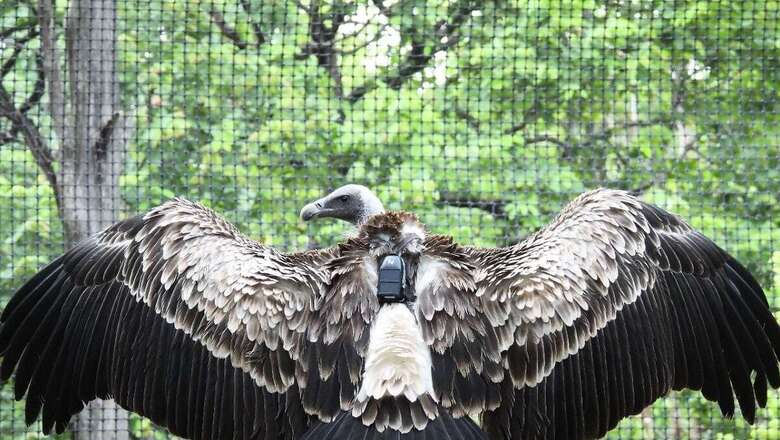
views
As many as 20 captive-bred, critically endangered vultures are ready for release into the wild at two of the tiger reserves in Maharashtra. Ten of them are Long-Billed, and the remaining are White-Rumped vultures — all part of the Gyps species fighting extinction worldwide with only a few thousands surviving.
“This is the first such release of the captive-bred, critically endangered vultures from Maharashtra,” said Kishor Rithe, Director, Bombay Natural History Society (BNHS). “We brought 20 birds from the Vulture Conservation Breeding and Research Center at Pinjore, Haryana, early this year and kept them in Pench Tiger Reserve and Tadoba Andhari Tiger Reserve. All of them have now been tagged and are ready to take flight.”
The GPS telemetry tags fitted on the birds will enable the staff to keep track of them after they take flight and monitor closely for at least a year using the devices and satellite transmitters. They will also keep an eye out for any behaviour changes to ensure they adapt to the wilderness.

These magnificent birds of prey were artificially hatched at Haryana’s Bir Shikargaha Wildlife Sanctuary in Pinjore, which houses India’s oldest vulture conservation breeding and research centre since 2001.
“The birds are roughly 4-5 years old and mature enough for release. As part of the soft-release process, we initially kept them in pre-release aviaries to acclimatise them with the local conditions and enable them to interact with the wild vultures before they are freed into their natural habitat,” said Dr Prabhu Nath Shukla, Field Director of Pench Tiger Reserve, Maharashtra.
Both the reserves had constructed aviaries to host the birds, where they were kept under the care of the researchers. The Long-billed Vultures were released in the pre-release aviary set up in East Pench range which has been a home to vultures for many years, while a new Jatayu Conservation Project was set up at the Tadoba Andhari Tiger by the Maharashtra Forest Department in order to re-establish the vulture population in the region, said the officials.
WHY ARE VULTURES IN DANGER OF EXTINCTION?
These magnificent birds of prey are fighting extinction due to the widespread use of the non-steroidal drug Diclofenac in cattle treatment. The drug leads to fatal poisoning among vultures. Since these giant birds are scavengers and feed on carcasses of cattle, their numbers suddenly plummeted from millions to a few thousands between 1990 and 2016.
The drug use for treatment of domestic cattle was so rampant that vultures, which were commonly seen near human settlements, began to disappear.
The International Union for Conservation of Nature (IUCN) classified three of the Gyps species — Long-Billed vulture, White-Backed vulture, and Slender-Billed vulture — as ‘Critically Endangered’, warranting immediate conservation measures. A total of four vulture conservation breeding centres were then set up across India in Haryana, Assam, Madhya Pradesh, and West Bengal to revive the bird population through breeding programmes. Total 30 birds have been reintroduced into the wild from all the centres so far.
India banned the use of Diclofenac for veterinary use in March 2006 and strengthened its conservation measures. The BNHS teams have been conducting pharmacy surveys, carcass sampling and educating cattle owners, and sensitising residents of nearby villages about vulture nesting colonies and vulture food to keep the keep birds safe at least within a 100 km periphery of each release site, even beyond the tiger reserves.



















Comments
0 comment